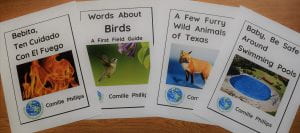Teaching people how to be safe has long been a passion for Camille Phillips, graduate student in the English department. After dealing with her father falling and the aftermath of his injuries, she decided that educating others on safety and preparedness was something that she wanted to do. Since then, she has taught fall prevention courses to the elderly and created safety books and field guides for children.
Phillips has always been interested in writing children’s books. Twenty years ago, she won second place in a Highlights for Children short story writing contest, but she felt that fiction writing was not for her. It would be many years before she realized that safety writing was her calling.
“Two years ago I was minding my own business,” Phillips said, “and maybe thinking writing for children was just a thought I would have to put on the shelf, when the traffic book just popped into my head.”
She quickly wrote down the story and noted the structure of it. A week later a cat book popped into her head.
“I have no idea where those books came from.”
Phillips’ safety books are written for kids to understand. She learned to communicate with younger audiences during the eight years that she spent teaching GED courses in writing and math.
“It’s very, very difficult to write for beginners and hardly anyone can do it,” she said. “We’re always assuming people [students] know more than they do. From that I have learned to write more simply.”
Her writing process is methodical. It begins with an idea and moves to research. She gathers information about the safety procedures and begins to construct her story. Using the beginning, middle, and end structure, words fall onto the page, forming a story that not only teaches children to be safe, but also affirms the emotions they might feel in a dangerous situation.
There are no people in her books and the pictures used are often unisex. In this way, Phillips hopes that her books go beyond diversity, allowing all children to see themselves in her stories. Central messages rhyme so that children will remember them, and at the end of the book she summarizes to reinforce what the child has read.
Phillips has something else that distinguishes herself from other safety book writers: her books are for children before birth and after.
“Moms and Grandmas have known for centuries that babies are learning before they are born.”
Current research supports this thinking. By reading safety books to kids while they are still in the womb, Phillips hopes to better prepare growing kids to handle dangerous situations. In the future, she would like to see this type of research tailored specifically to safety books.
In her fire book, Phillips wants children to understand that although fire has many useful purposes, it can also be very dangerous. The story introduction notes many uses for fire. She doesn’t want children to fear fire in general. Instead, she wants them to be cautious around it and know how to respond in a dangerous situation. An important and often overlooked part of a response process is knowing how to react when emotions arise.
“My books include emotions, and oftentimes safety books do not,” she said. “There is nothing that says ‘you may be upset, but we’ll help you and we’ll get through this.’ If we get stuck in our feelings, we won’t be able to do what we need to do to save ourselves.”
Phillips’ children’s books also cover topics beyond safety. Her fruit and vegetable books offer a wonderful introduction to nutrition, and they include interactive sections to get children excited about healthy eating. Her field guides overflow with information about different kinds animals that children can identify in their everyday lives. She is extremely proud of her cat and dog books that teach about different breeds. Adults can use the parent-teacher guide for this book to help teach children about bias and stereotypes.
Phillips credits her liberal arts education with building her research skills and the ability to think creatively. She is currently a graduate student in the M.A. in Literature program, and she also received a bachelor’s degree from Texas State University with a double major in German and Spanish. This education has also made it possible for her to read between the lines and evaluate complicated subjects objectively and thoroughly. Dr. Marilyn Olson specifically has had a great influence on Camille’s writing. Only time will tell what the future holds for the accomplished author, and her growing library of books for children and adults alike.

